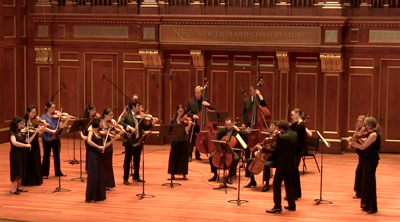by Daniel Hathaway

Four selections arranged by AFC violinist Alex Fortes from a medieval collection associated with the Cathedral of Santiago de Compostela began with “Regem regum dominum,” where a long, unison chant line was spun out with impressive unanimity and nuance by all 18 players. Duos — some doubled — solos, and various combinations of instruments delivered ancient music engagingly to modern ears in a Prosa and two Benedicamus tropes, one of them thought to be the first surviving example of three-part polyphony.
Jay Cosmos Lee and Megumi Stohs Lewis were featured in full-throated solo roles in Bach’s Double Violin Concerto. AFC’s musical energy was infectious. Playing with minimal vibrato and vivid color, the Criers — as they nickname themselves — made dramatic crescendos and crafted sudden echo passages. The players communicated closely with each other, and their visceral engagement in the music was fun to watch.

Beecher wrote individual parts for each of the eighteen performers, basing them on their individual musical personalities. Bird noises abound and increase in intensity as the congregation gathers and takes flight. The denouement (the third section of the piece) is ineffably sad, gradually fading away with all but four of the players rubbing sandpaper together under a long string solo and chorale.
Though Conference sounded fresh and original, it might gain in impact with a bit of editing. It loses steam about fifteen minutes into the piece — the point on Tuesday when the otherwise rapt audience began to fidget. But keep an ear on Beecher. He owns his own compositional voice and has some interesting projects in the works.
The evening ended with one of the three works in the Tintinnabulation style that Estonian composer Arvo Pärt used to break his decade of compositional silence. Tabula Rasa (“Blank Slate”) is a double violin concerto of a sort, enhanced by a prepared piano that sounds like eerie, distant chimes. Soloists Alex Fortes and Miki-Sophia Cloud began “Ludus” (“Play”) with widely-spaced A’s, alternating sound and silence while shaping an a-minor chord in various configurations. In “Silentium,” the solo violins add more pitches to their repertoire, finally reaching a D at the apex of the movement. A long fadeout leads to silence (an extended moment, ritualistically held by Fortes). The piece is like a Japanese Noh play — a nearly motionless context in which tiny events like pitch changes seem seismic.
A Far Cry achieved an exceptional sense of ensemble in this unusual program — all the more impressive because ten of the eighteen performers on Tuesday were tagged in the roster as “Guest Criers.” Boston obviously has a pool of excellent freelancers.
Photo: A Far Cry performing in Boston’s Jordan Hall.
Published on ClevelandClassical.com January 30, 2017.
Click here for a printable copy of this article



